CHECK OUT THIS GUIDE:
OWN YOUR ORDERS: THE THIRD-TO FIRST-PARTY PLAYBOOK
Marketing
DEC 02, 2021
Share
Picture this: you’ve been awake since 6 am, and it’s been a grueling day at work. As the clock inches closer to 5 pm, the only thing you want to do is curl up on the couch and nosh on some comfort food while watching Netflix. The only problem? Cooking food. Delivery take-out food to the rescue!
Food delivery is the busy person’s savior, and about 43 percent of people say they order delivery because they don’t feel like cooking. In the U.S., this service has experienced rapid growth over the past five years; in 2015, 66 million people used food delivery services, and in 2020 this number increased to 111 million.
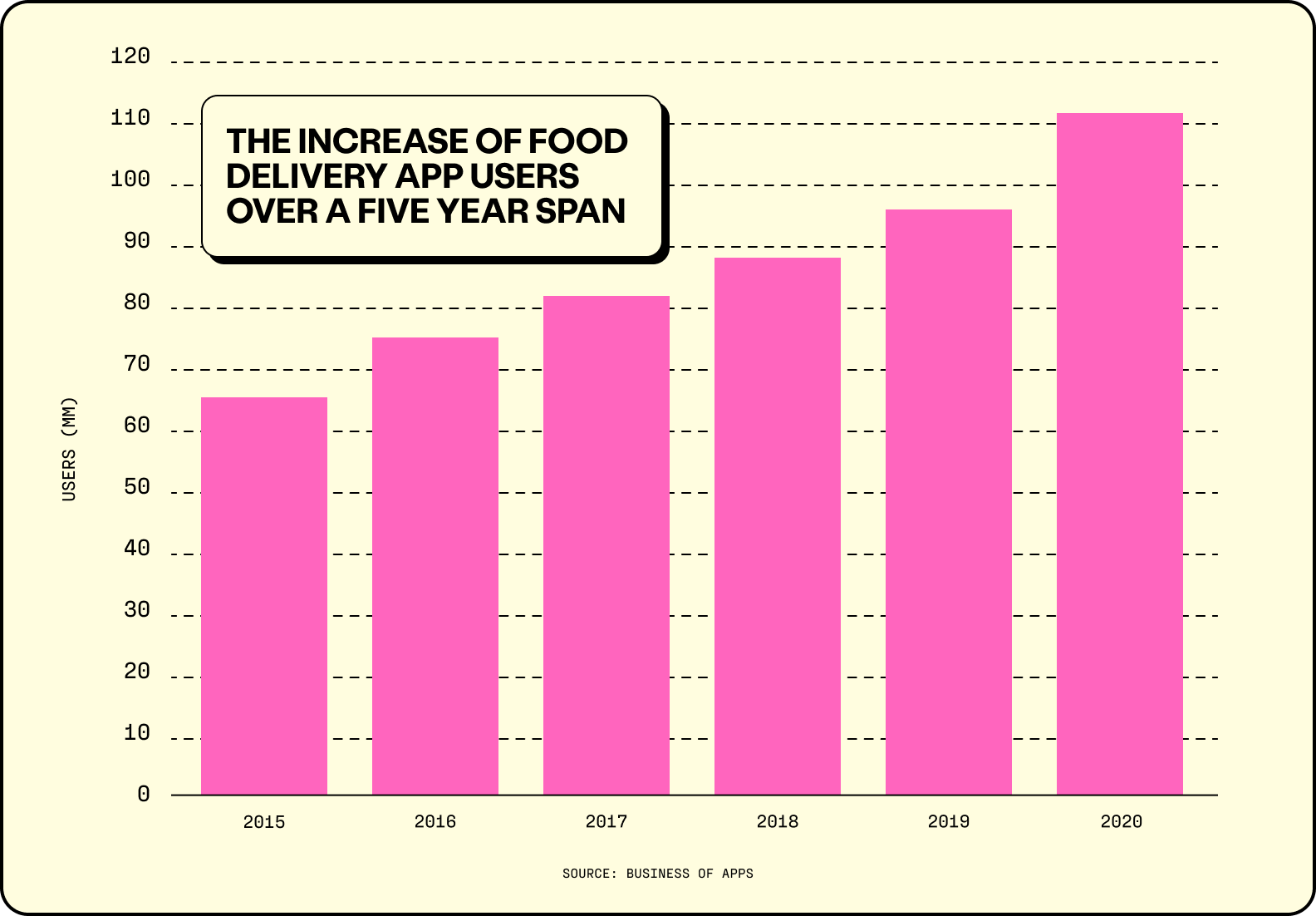
Of course, the COVID-19 pandemic radically changed how consumers interacted with restaurants and threatened the ability of these establishments to stay open. One of the only ways to survive as a restaurant during the height of the pandemic was to offer food delivery.
Not all restaurants had then, or even have now, their own in-house delivery services. Partnerships with third-party delivery services like GrubHub, Postmates, UberEats, and DoorDash were the immediate solution to still conducting business after the pandemic started.
Even though these platforms functioned as lifelines during lockdowns, they were still problematic. Many restaurants complained that these delivery services took advantage of them in a time of desperation.
Restaurants often operate on razor-thin profit margins, and commission fees charged per order by third-party delivery services can result in minimal to no profit for the restaurant. Now, cities are placing commission caps on delivery services in order to protect restaurants.
About 6 months after the start of the COVID-19 pandemic, approximately 58 percent of people surveyed in a research study reported they felt uncomfortable dining in a restaurant. Having some form of a food delivery service may be a crucial factor for accommodating these customers. Many customers who developed a habit of ordering food delivery during the lockdowns will likely continue to have this expectation of restaurants moving forward, even after restaurants are fully open for dining-in.
Food delivery is incredibly convenient for the customer. Ordering food and picking it up is also convenient, but this still involves the customer driving and finding parking. Picking up dinner during rush hour traffic can be a nightmare, and defeat the purpose of ordering food for the sake of convenience.
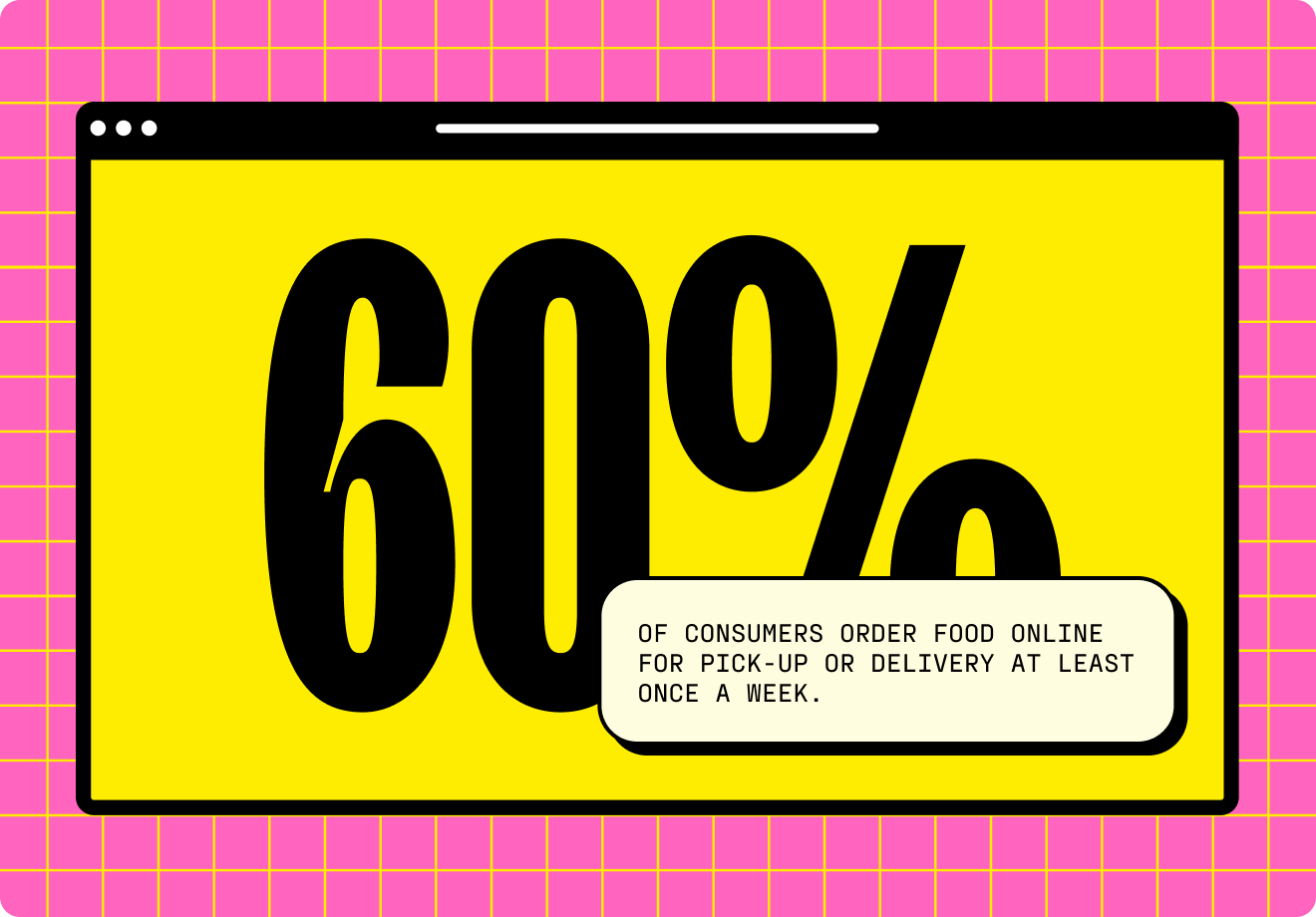
Approximately 60 percent of consumers order food online for pick-up or delivery at least once a week. If your restaurant does not offer a delivery driver option and a customer cannot drive to pick up take-out food, they will likely choose another restaurant, thus leading to loss of profits and customer loyalty.
Food delivered during the height of lockdowns became a habit for many households. Although customers are now returning to indoor dining, many have still kept this habit. Some customers may still not feel comfortable dining in, and ordering food to be delivered may be the only way they will order from your restaurant. Food delivery is now a table-stakes business model for restaurants.
With restaurant delivery companies booming in the past few years, the main focus has been on big players in this space like Doordash, UberEats, and GrubHub. However, providing in-house delivery (also called first-party delivery) is another option for your restaurant. After all, this was the original option for food delivery before third-party platforms emerged.
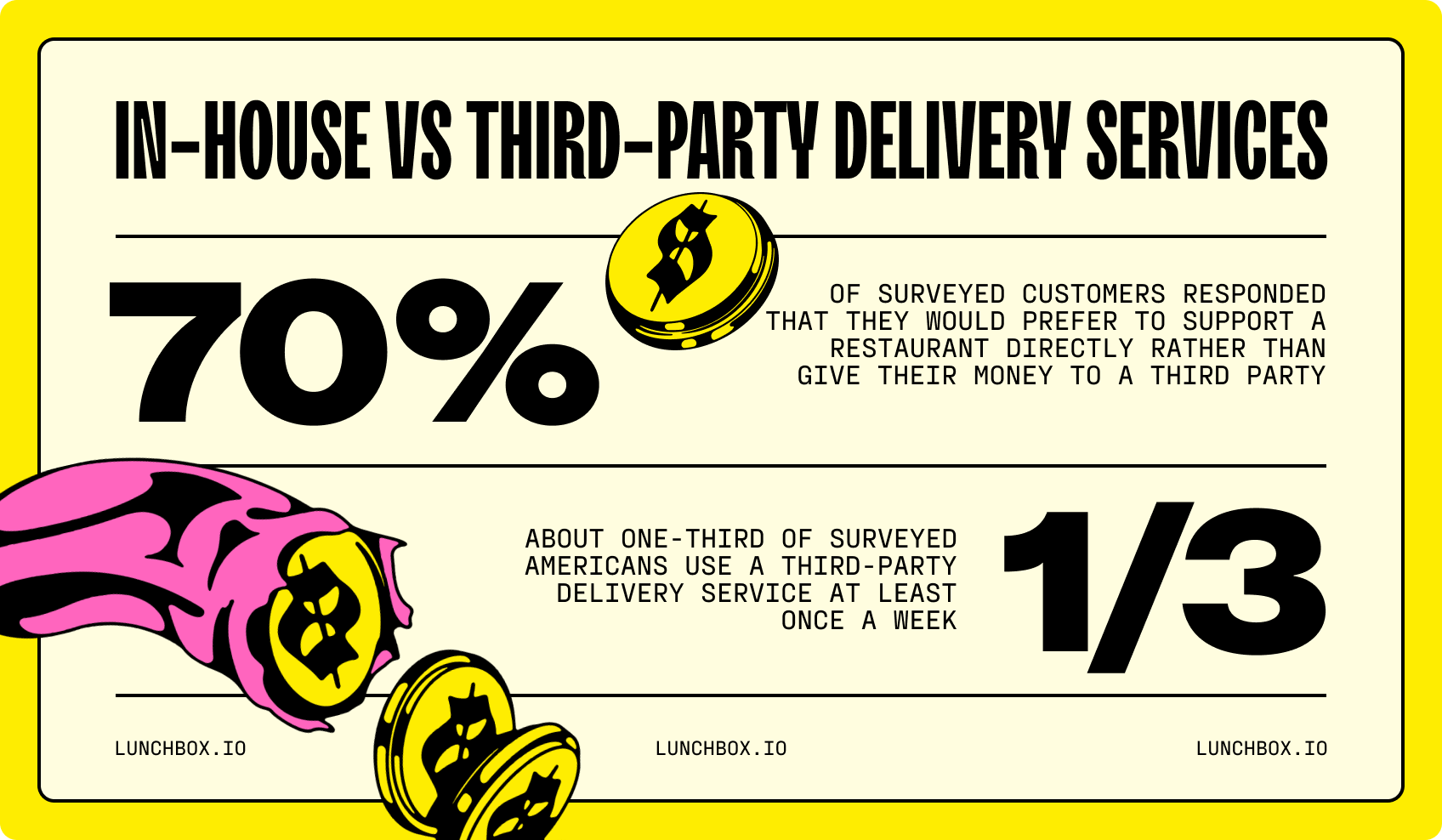
About one-third of surveyed Americans use a third-party delivery service at least once a week. That being said, customers want to support their local restaurants. 70 percent of surveyed customers responded that they would prefer to support a restaurant directly rather than give their money to a third party.
CHECK OUT THIS GUIDE:
OWN YOUR ORDERS: THE THIRD-TO FIRST-PARTY PLAYBOOK
Whether you decide on in-house delivery options or third-party, there are a few factors to consider prior to making a decision.
Offering food delivery should help increase revenue and profits, not take a toll on it. Many restaurants need to prioritize profit to make a comeback after the economic impact of the COVID-19 pandemic. Third-party delivery services have been notorious for taking high commission fees from restaurants, so in-house delivery may help keep more money in a restaurant’s pocket. However, some restaurants don’t have the bandwidth or resources for in-house delivery.
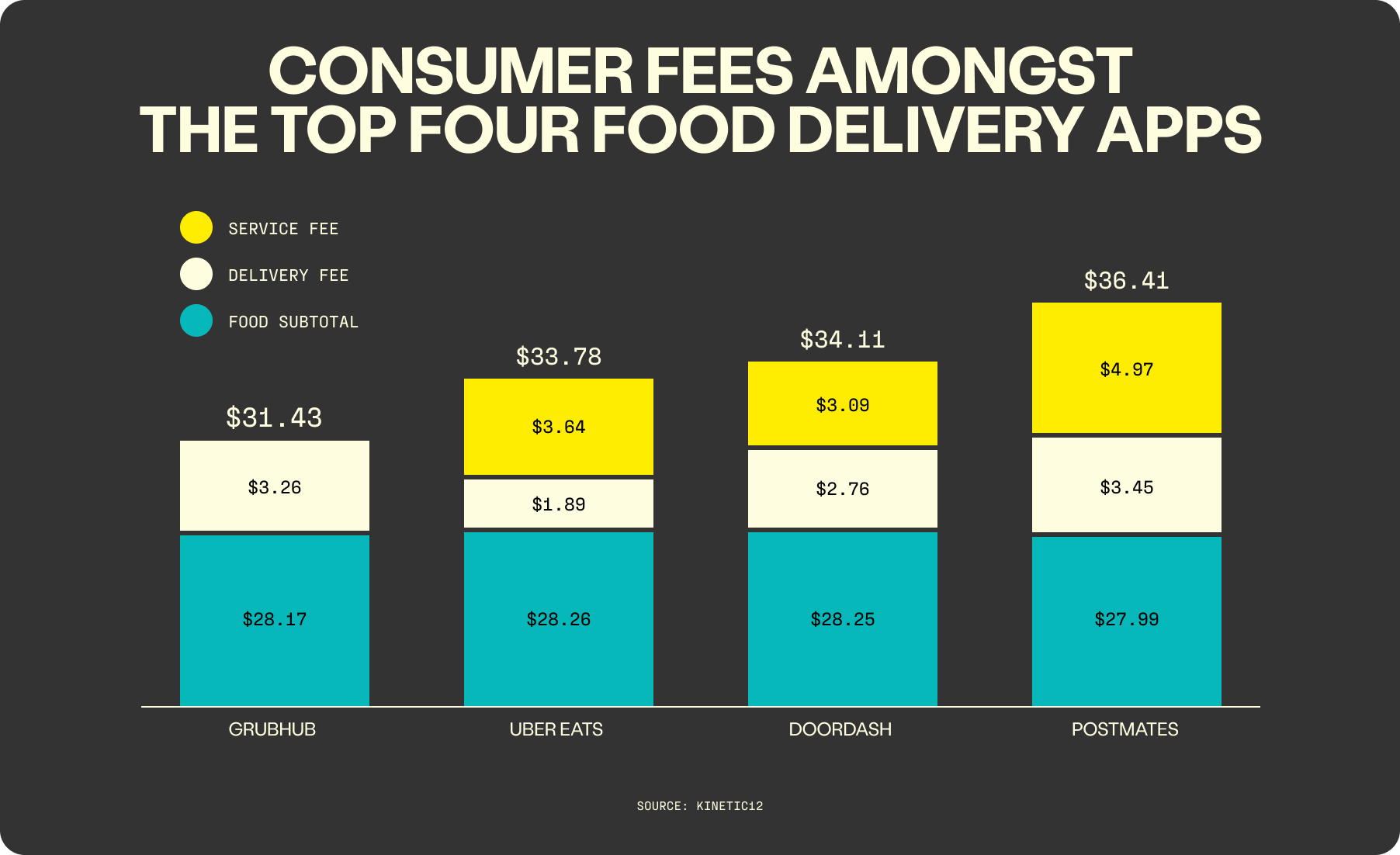
Delivery fees can be the deciding factor if customers decide to order from your restaurant or not. Food delivery apps can tack fees on top of the delivery fee, and this fee can increase with distance. Can your restaurant offer a delivery service that is competitive to what third-party services charge, while still maintaining a profit? For restaurants providing their own delivery service, free delivery can be offered as an incentive for customers that spend a certain amount on their order.
Customer data can provide restaurants insight on spending habits, trends, profitable menu items, and even personal preferences. All of this information can be important for making informed business decisions. Unfortunately, most third-party delivery services do not offer this data to restaurants.
CHECK OUT OUR EBOOK ON USING CUSTOMER DATA FOR MARKETING
On the other hand, the decision to not allow restaurants to have access to this data is meant to protect customer privacy. Restaurants that are easily able to gather this data may not have privacy policies in place, therefore making this data at risk for misuse. There are other ways to gather useful customer data and encourage customer loyalty when using a delivery service (see “Things to Consider When Using Third-Party Delivery Services” below).
There are, of course, many positives to being able to access customer data. Equipped with this information, restaurants can create personalized marketing for customers based on their birthday, order frequency, and time of the year. First-party data can be great for brand building and establishing connections with customers.
With in-house delivery, you may be limited to how far you are able to deliver. However, you may know that delivering to an address 15 minutes away will cause the food to become cold and soggy, and therefore you have the authority to limit your delivery radius to 5-10 minutes away.
If choosing a delivery service to work with, check to make sure they are able to service the area in which your restaurant is located. Determine the radius and reach this service already has in your community. As a restaurant, you will have less control of how far your food travels, running the risk of the courier bringing the customer cold, unfresh food.
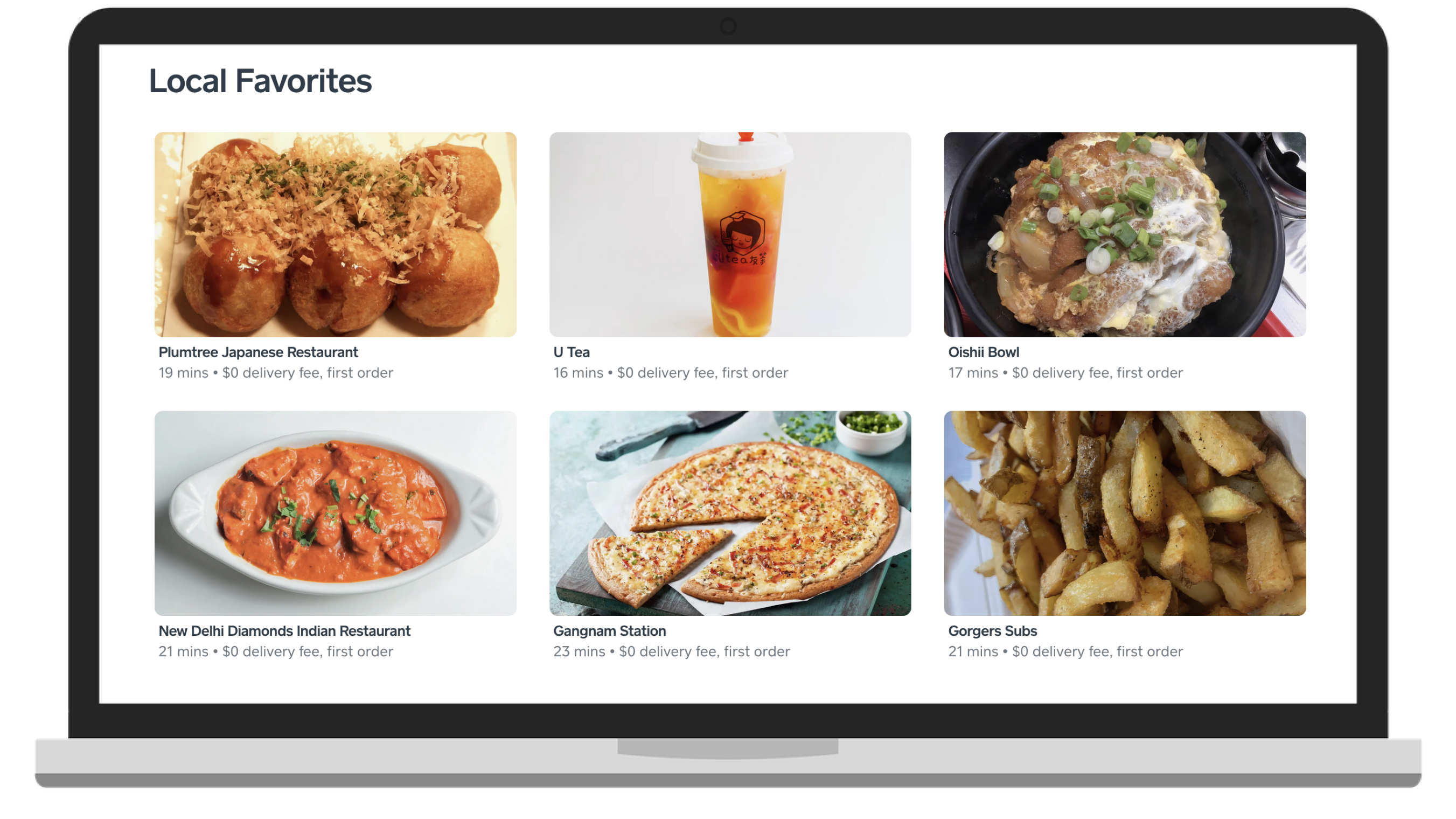
Example of how Caviar showcases restaurants in the user’s area. Source: Caviar
Third-party marketplaces are widely viewed as a “customer discovery platform” to restaurants. When entering a new delivery area or testing out a new concept, 3rd-party apps are a good way to see if there is appetite for your food before developing a larger brand experience.
If a customer is looking to order takeout food, they may not know exactly what they want to eat yet. Therefore, scrolling through a food delivery app might help them decide. If your restaurant is listed as an option on an app, this automatically increases your brand awareness. Customers are able to select cuisine and dietary preferences on apps, giving your restaurant the opportunity to differentiate from other establishments in the area. Some apps even highlight new or popular restaurants that are partners.
But when you use third-party marketplaces, your visibility is somewhat out of your control. You could be the first restaurant that appears for a customer, but you could also be overshadowed by others who pay big bucks for promotional spots.
When it comes to food delivery, your restaurant has two options: offering in-house delivery or partnering with a third-party delivery service. Third-party delivery platforms typically charge a commission fee ranging anywhere from 15-35 percent of the order. However, this information is not always available upfront, and this fee depends on what package your restaurant signs up for. On top of this, it is often difficult to be aware of what service fees your customers are being charged.
Now, many cities are placing caps on how high commission fees can be in order to assist struggling restaurants. In many cases, these fees are being transferred to the customer. Checking to see if your city has placed caps on commission fees for delivery platforms may help you determine if in-house or outsourcing is the better option.
In-house delivery gives the restaurant full control of this service. Customer data is easy to access with this option, and chances are your restaurant will be able to increase its revenue on delivery orders. There are many different technologies that exist to help restaurants provide in-house delivery - including Lunchbox!
One con to consider with in-house delivery is that by taking it on yourself, your restaurant now assumes full responsibility for the delivery experience. The food arrived cold? That’s on your restaurant. On the other hand, this gives you the opportunity to provide spectacular delivery service and impress your customers.
UberEats stems from its ride service parent company, Uber. Because Uber was the first ride service app, its platform is already well-established with many customers and available drivers, which has translated to the UberEats branch. As the global leader, this delivery service has a massive reach and is available in 6,000 cities throughout six continents.
Commission Fees: 15-30 percent.
Service Fees: varies.
GrubHub is the oldest and most established food delivery service amongst the big players, and it now owns multiple brands: OrderUp, Eat24, Foodler, Seamless. Across all of its brands and apps, GrubHub has about 14.5 million users in 2,700 cities in all 50 U.S. states.
Commission Fees: 30 percent.
Service Fees: varies.
DoorDash processed 45 percent of all food deliveries in 2020, making it the most popular food delivery app on the market in the United States. An estimated 18 million customers use the app, and its delivery services are available in 900 U.S. cities across 50 states.
Commission Fees: 15-30 percent
Service Fees: $2.99-$4.99, also offers monthly membership of $9.99
As a newer company, Caviar is currently only available in 11 major U.S. cities. Compared to other delivery services, its commission fees are on the lower end. The company is more selective with what restaurants it partners with, and tends to work with more high-end establishments overall.
Commission Fees: Approximately 20 percent per order
Service Fees: Typically between $2-$8
Postmates has a larger reach in the U.S., as it is available in over 1,500 cities across 50 states. However, it only accounts for 12 percent of the delivery market, meaning fewer customers use it.
Commission Fees: Around 30 percent
Service Fees: Varies. A monthly customer membership is available for $10.
In addition to the big players in the food delivery space, there are other companies offering delivery services in specific areas of the United States with niche focuses and features. Many of these smaller services are focused on supporting local restaurants and offer special services to achieve this goal. Here are a few examples:
Favor (Texas) - This delivery service says that it is “the easiest way to get anything delivered in under an hour.” It operates in over 200 cities in Texas, and employs 1000,000 “runners”. In addition to food delivery, the runners can shop for household and office items and even run errands.
EatOkra (Across the U.S.) - Operating across the U.S. with over 9,500 restaurant listings, this app and delivery app has serviced 350,000 users. EatOkra’s goal is to connect foodies to Black restaurants and culinary events while amplifying the dining experience for and by Black communities.
Chekout (New York City) - One of the newer delivery services, Chekout recently launched in the New York City area. It aims to benefit restaurants by not charging them to use the service, and charges a flat delivery rate of $2.50 and a maximum 10% service fee to customers.
For the time being, using a third-party service delivery service may be the best option for your restaurant. Logistically, it can be much quicker and streamlined to go this route. Partnering with delivery services will reduce overhead costs. Some restaurants might not be equipped for in-house delivery due to being short-staffed, the inability to procure delivery vehicles, or lack of time and/or funds.
At some point, this may change and your restaurant might decide that in-house delivery is possible and a better choice. If working with a delivery service outside of your restaurant, there are still steps you can take to connect with your customer base and ensure loyalty.
Customers love deals and supporting their local restaurants. Therefore, consider adding a coupon code to use online ordering systems/ordering directly from the restaurant.
Focusing on customer loyalty is always an option, no matter what delivery service your restaurant offers. Loyalty programs are appealing to customers, and this is one way to offer an incentive for them to keep coming back and spending more. In fact, customers who are a part of a loyalty program were found to spend twice as much compared to those who were not.
Even if your restaurant is not able to access customer data, there are still methods to gather customer information in order to offer a personalized experience. On your restaurant’s website or online ordering system, you can offer an incentive, like a certain percentage off their next order or a free drink, for customers that share their email address. This allows you to directly market to the customer.
The popularity of food delivery has been steadily increasing over the past five years, and the coronavirus-induced lockdowns have rapidly increased this market’s growth. With no sign of food delivery slowing down, restaurants should consider whether in-house or a third-party delivery service is the better option. Although there are many factors to determine what service is ideal, having some form of food delivery is better than none - especially for customers who have developed an expectation for this service.
ENTER YOUR EMAIL TO STAY IN THE KNOW!